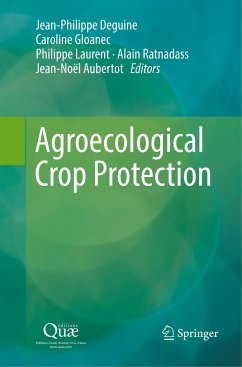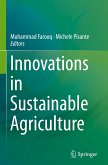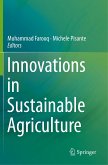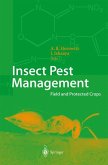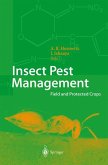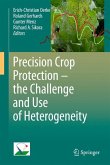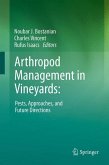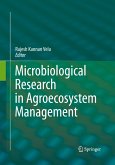Agroecological Crop Protection
Herausgegeben:Deguine, Jean-Philippe; Gloanec, Caroline; Laurent, Philippe; Ratnadass, Alain; Aubertot, Jean-Noël
Agroecological Crop Protection
Herausgegeben:Deguine, Jean-Philippe; Gloanec, Caroline; Laurent, Philippe; Ratnadass, Alain; Aubertot, Jean-Noël
- Broschiertes Buch
- Merkliste
- Auf die Merkliste
- Bewerten Bewerten
- Teilen
- Produkt teilen
- Produkterinnerung
- Produkterinnerung
This book is devoted to Agroecological Crop Protection, which is the declension of the principles of agroecology to crop protection. It presents the concepts of this innovative approach, case studies and lessons and generic keys for agroecological transition. The book is intended for a wide audience, including scientists, experimenters, teachers, farmers, students. It represents a new tool, proposing concrete keys of action on the basis of feedbacks validated scientifically. Beyond the examples presented, it is therefore of general scope and proposes recommendations for all temperate and…mehr
Andere Kunden interessierten sich auch für
![Innovations in Sustainable Agriculture Innovations in Sustainable Agriculture]() Innovations in Sustainable Agriculture187,99 €
Innovations in Sustainable Agriculture187,99 €![Innovations in Sustainable Agriculture Innovations in Sustainable Agriculture]() Innovations in Sustainable Agriculture186,99 €
Innovations in Sustainable Agriculture186,99 €![Insect Pest Management Insect Pest Management]() Insect Pest Management116,99 €
Insect Pest Management116,99 €![Insect Pest Management Insect Pest Management]() A. Rami Horowitz / Isaac Ishaaya (Hgg.)Insect Pest Management121,99 €
A. Rami Horowitz / Isaac Ishaaya (Hgg.)Insect Pest Management121,99 €![Precision Crop Protection - the Challenge and Use of Heterogeneity Precision Crop Protection - the Challenge and Use of Heterogeneity]() Precision Crop Protection - the Challenge and Use of Heterogeneity186,99 €
Precision Crop Protection - the Challenge and Use of Heterogeneity186,99 €![Arthropod Management in Vineyards: Arthropod Management in Vineyards:]() Arthropod Management in Vineyards:208,99 €
Arthropod Management in Vineyards:208,99 €![Microbiological Research In Agroecosystem Management Microbiological Research In Agroecosystem Management]() Microbiological Research In Agroecosystem Management112,99 €
Microbiological Research In Agroecosystem Management112,99 €-
-
-
This book is devoted to Agroecological Crop Protection, which is the declension of the principles of agroecology to crop protection. It presents the concepts of this innovative approach, case studies and lessons and generic keys for agroecological transition. The book is intended for a wide audience, including scientists, experimenters, teachers, farmers, students. It represents a new tool, proposing concrete keys of action on the basis of feedbacks validated scientifically. Beyond the examples presented, it is therefore of general scope and proposes recommendations for all temperate and tropical cropping systems. It contributes to the training and teaching modules in this field and it is an updated information support for professionals and a teaching aid for students (agronomy, crop protection, biodiversity management, agroecology).
Produktdetails
- Produktdetails
- Verlag: Springer / Springer Netherlands / Éditions Quæ
- Artikelnr. des Verlages: 978-94-024-1505-6
- Softcover reprint of the original 1st ed. 2017
- Seitenzahl: 280
- Erscheinungstermin: 7. Juni 2019
- Englisch
- Abmessung: 235mm x 155mm x 16mm
- Gewicht: 436g
- ISBN-13: 9789402415056
- ISBN-10: 940241505X
- Artikelnr.: 54773942
- Herstellerkennzeichnung Die Herstellerinformationen sind derzeit nicht verfügbar.
- Verlag: Springer / Springer Netherlands / Éditions Quæ
- Artikelnr. des Verlages: 978-94-024-1505-6
- Softcover reprint of the original 1st ed. 2017
- Seitenzahl: 280
- Erscheinungstermin: 7. Juni 2019
- Englisch
- Abmessung: 235mm x 155mm x 16mm
- Gewicht: 436g
- ISBN-13: 9789402415056
- ISBN-10: 940241505X
- Artikelnr.: 54773942
- Herstellerkennzeichnung Die Herstellerinformationen sind derzeit nicht verfügbar.
The editors of this book are: Jean-Philippe Deguine, Caroline Gloanec, Philippe Laurent, Alain Ratnadass and Jean-Noël Aubertot
Foreword.- Preamble.- Preface.- Thanks.- Introduction.- 1. APPLYING AGROECOLOGICAL PRINCIPLES TO CROP PROTECTION.- Outlines of Agroecology.- Agroecology, a 21st century agricultural revolution?.- Agroecology seen by an evolutionist ecologist.- Can agronomy be merged into agroecology?.- Agroecology and frames of reference: an epistemological reading.- Evolution of crop protection.- A critical look through the eyes of a science historian of the development of crop protection.- Moving from integrated pest management to agroecological crop protection.- Agroecological crop protection: at the interface between agroecology, crop protection and biodiversity management.- Conclusion.- 2. APPLICATION TO VEGETABLE CROPS: THE GAMOUR EXPERIENCE.- 3. APPLICATION IN FRUIT CROPS: THE BIOPHYTO EXPERIENCE.- 4. FEEDBACK AND COMMON APPROACHES TO AGROECOLOGICAL CROP PROTECTION: FURTHER EXAMPLES.- Introduction.- Other experiences in vegetable farming.- Agroecological practices to manage soil-borne pathogensin greenhouse vegetable crops in France.- Agroecological management of bacterial wilt of tomato in Martinique.- Other Experiments in Fruit Arboriculture.- Managing plant ground cover to control pests in apple orchards in France.- Agroecological Management of Mango Fruit Flies in Benin.- Experiences with other crops.- Agroecological management of banana pests in export crops in the Dominican Republic.- Agroecological management of insect pests of rainfed rice in Madagascar.- Approach to Biodiversity at the Agroecosystem Level. -Initiatives for Functional Biodiversity in Viticulture and Natural Pest Regulation Services.- Semi-natural habitats for functional biodiversity in France.- Design and Multicriteria Evaluation of Innovative Cropping Systems.- Rés0Pest: An experimental network of pesticide-free cropping systems.- Conclusion.- 5. AGROECOLOGICAL TRANSITION KEYS.- Introduction.- Choosing and adapting methods.- A synoptic view of the methods available to achieve ACP.- Basic pest control techniques.- Diagnoses in agricultural plots.- Experiments on cropping systems.- Modeling, an essential tool for ACP.- Creating and utilizing knowledge.- Functional Soil and Aerial Biodiversity.- Effects of agricultural practices on biotic stresses.- Organic farming as a prototype for the development of ACP.- Landscape ecology, approximation between agronomy and ecology.- Implementing and assessing practices.- Experimental systems and co-design.- Multi-criteria evaluation.- Mediation tools: support for implementation of ACP.- Tracking trajectories.- Training and knowledge transfer.- Teaching ACP.- New training methods: self-training and on-line learning.- Promotion and transfer through vocational training: CUQP ACP.- Concerted public strategies for the support and promotion of agroecology: the approach in Reunion.- The key to agroecological transition: farmers' testimonies.- Agroecology as seen by a farmer in Vendée.- Applied agroecology in a young tropical orchard.- Conclusion.- General conclusion: ACP, a Crop Protection policy for the Future.- Acronyms and abbreviations.- Bibliography.- List of authors.
Foreword.- Preamble.- Preface.- Thanks.- Introduction.- 1. APPLYING AGROECOLOGICAL PRINCIPLES TO CROP PROTECTION.- Outlines of Agroecology.- Agroecology, a 21st century agricultural revolution?.- Agroecology seen by an evolutionist ecologist.- Can agronomy be merged into agroecology?.- Agroecology and frames of reference: an epistemological reading.- Evolution of crop protection.- A critical look through the eyes of a science historian of the development of crop protection.- Moving from integrated pest management to agroecological crop protection.- Agroecological crop protection: at the interface between agroecology, crop protection and biodiversity management.- Conclusion.- 2. APPLICATION TO VEGETABLE CROPS: THE GAMOUR EXPERIENCE.- 3. APPLICATION IN FRUIT CROPS: THE BIOPHYTO EXPERIENCE.- 4. FEEDBACK AND COMMON APPROACHES TO AGROECOLOGICAL CROP PROTECTION: FURTHER EXAMPLES.- Introduction.- Other experiences in vegetable farming.- Agroecological practices to manage soil-borne pathogensin greenhouse vegetable crops in France.- Agroecological management of bacterial wilt of tomato in Martinique.- Other Experiments in Fruit Arboriculture.- Managing plant ground cover to control pests in apple orchards in France.- Agroecological Management of Mango Fruit Flies in Benin.- Experiences with other crops.- Agroecological management of banana pests in export crops in the Dominican Republic.- Agroecological management of insect pests of rainfed rice in Madagascar.- Approach to Biodiversity at the Agroecosystem Level. -Initiatives for Functional Biodiversity in Viticulture and Natural Pest Regulation Services.- Semi-natural habitats for functional biodiversity in France.- Design and Multicriteria Evaluation of Innovative Cropping Systems.- Rés0Pest: An experimental network of pesticide-free cropping systems.- Conclusion.- 5. AGROECOLOGICAL TRANSITION KEYS.- Introduction.- Choosing and adapting methods.- A synoptic view of the methods available to achieve ACP.- Basic pest control techniques.- Diagnoses in agricultural plots.- Experiments on cropping systems.- Modeling, an essential tool for ACP.- Creating and utilizing knowledge.- Functional Soil and Aerial Biodiversity.- Effects of agricultural practices on biotic stresses.- Organic farming as a prototype for the development of ACP.- Landscape ecology, approximation between agronomy and ecology.- Implementing and assessing practices.- Experimental systems and co-design.- Multi-criteria evaluation.- Mediation tools: support for implementation of ACP.- Tracking trajectories.- Training and knowledge transfer.- Teaching ACP.- New training methods: self-training and on-line learning.- Promotion and transfer through vocational training: CUQP ACP.- Concerted public strategies for the support and promotion of agroecology: the approach in Reunion.- The key to agroecological transition: farmers' testimonies.- Agroecology as seen by a farmer in Vendée.- Applied agroecology in a young tropical orchard.- Conclusion.- General conclusion: ACP, a Crop Protection policy for the Future.- Acronyms and abbreviations.- Bibliography.- List of authors.

